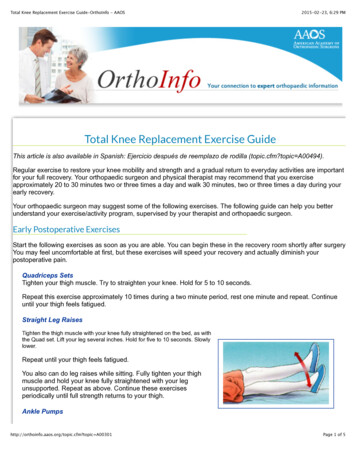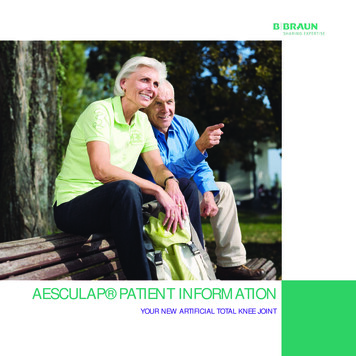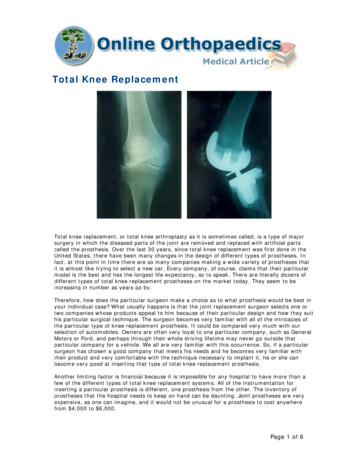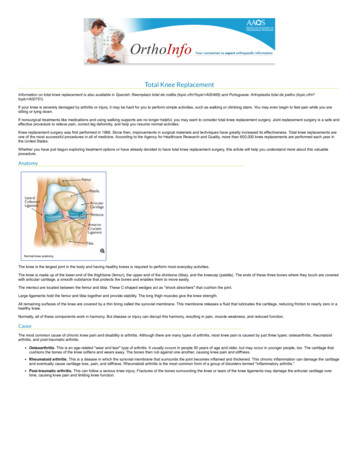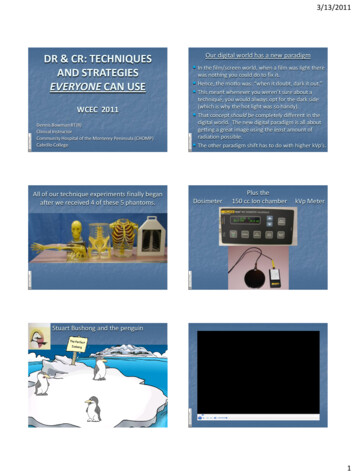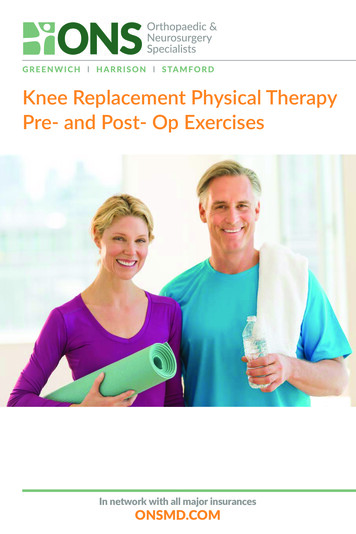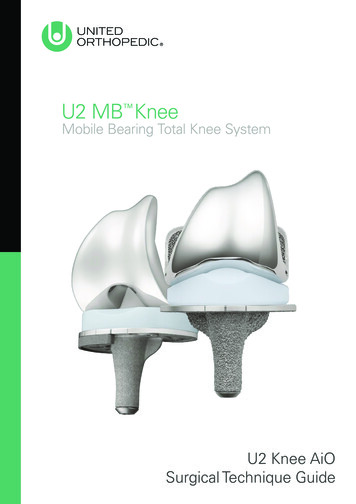
Transcription
Sung et al. BMC Musculoskeletal (2019) 20:320RESEARCH ARTICLEOpen AccessReliability and validity of knee extensorstrength measurements using a portabledynamometer anchoring system in asupine positionKwan-Sik Sung1, You Gyoung Yi2 and Hyung-Ik Shin2*AbstractBackground: Muscle strength measurements using hand-held dynamometry (HHD) can be affected by the inadequatestrength of the tester and lack of stabilization of the participants and the device. A portable HHD anchoring system wasdesigned that enabled the measurement of isometric knee extensor muscle strength in a supine position. This can be usedwith individuals who are unable to assume the sitting position required for the measurement of knee extensor strength inconventional isokinetic dynamometry (IKD). The aim of this study was to evaluate the reliability and validity of knee extensorstrength measurements using this device.Methods: The maximal knee extensor isometric strength of the dominant leg in healthy adults aged 20 to 40 years wastested. Three trials of three contractions were assessed by two raters using the portable dynamometer anchoring systemwhilst the participant was in the supine position. After the three measurement trials, peak knee extensor torque wasevaluated using IKD. The intraclass correlation coefficient (ICC) and 95% limits of agreement (LOA) for intra- and inter-raterreliability were obtained.Results: Thirty-nine participants (19 male and 20 female, aged 30.08 4.16 y), completed the three measurement trials.The ICC for intra-rater reliability was 0.98 for the maximum measurements of knee extensor strength (95% confidenceinterval [CI]: 0.96–0.98) and 0.98 (95% CI: 0.96–0.99) for inter-rater reliability. The mean difference (%) between themaximum knee extensor strength measurements of each trial was 1.02% (LOA range: 11.13 to 13.16%) for intra-raterand 1.44% (LOA range: 13.98 to 11.08%) for inter-rater measurements. The Pearson correlation coefficient of themaximum voluntary peak torque measurements with the portable dynamometer anchoring system and IKD was 0.927.Conclusions: The portable dynamometer anchoring system is a reliable and valid tool for measuring isometric kneeextensor strength in a supine position. Future clinical feasibility studies are needed to determine if this equipment can beapplied to people with severe illness or disabilities.Trial registration: KCT0003041.Keywords: Hand-held dynamometry, Supine, Portable dynamometer anchoring system* Correspondence: hyungik1@snu.ac.kr2Department of Rehabilitation Medicine, Seoul National University Hospital,Seoul National University College of Medicine, 101 Daehak-Ro, Jongno-Gu,Seoul 03080, Republic of KoreaFull list of author information is available at the end of the article The Author(s). 2019 Open Access This article is distributed under the terms of the Creative Commons Attribution 4.0International License (http://creativecommons.org/licenses/by/4.0/), which permits unrestricted use, distribution, andreproduction in any medium, provided you give appropriate credit to the original author(s) and the source, provide a link tothe Creative Commons license, and indicate if changes were made. The Creative Commons Public Domain Dedication o/1.0/) applies to the data made available in this article, unless otherwise stated.
Sung et al. BMC Musculoskeletal Disorders(2019) 20:320BackgroundLoss of muscle strength in adulthood has been linked tofrailty [1], increased risk of disability [2, 3], and mortality[4]. Lower extremity muscle strength affects posturalstability and gait [5] and also predicts survival in middleage and later life [6, 7]. Therefore, lower-extremity musclestrength assessment is essential for clinicians [8].Muscle strength can be evaluated using manual muscletesting (MMT), hand-held dynamometry (HHD), and isokinetic dynamometry (IKD) [9]. Although IKD is considered to be the gold standard for measuring strength [10],the equipment is large, expensive, lacks portability, and requires time-consuming testing and training sessions [11–13]. Thus, the application of IKD is impractical in manyclinical settings.Compared to IKD for muscle strength assessment, HHDdevices are simple, portable, relatively inexpensive, and canbe used at the bedside [11, 12, 14]. However, the accuracyof HHD measurements can be affected by lack ofstabilization of the participants and the device [9]. Especially, isometric strength can be underestimated if theexaminer is unable to oppose enough force to keep thetested limb in a fixed position [15].To address the concerns associated with HHD devices,several anchoring systems to fix the HHD have been usedwith favorable results [10, 16–20]. However, these anchoringsystems required the HHD to be fixed to the wall [10, 16]or to be constructed on the examination table prior to use[17–21]. When the system is used on the patients’ bed, thebed must be moved to an appropriate place for the measurement, or the anchoring systems must be installed everytime another patient is measured. Therefore, it may be morepractical to move patients to the laboratory rather than toconduct bedside measurements. However, this is not possible in severe cases such as in patients who are admitted tothe intensive care unit. Therefore, although portability isPage 2 of 8considered to be an advantage of HHD, the HHD anchoringsystems reported in previous studies limit portability.We designed a simple, more portable HHD anchoringdevice that can measure knee extensor muscle strength in asupine posture on a hospital bed. The aim of this study wasto examine the reliability and validity of knee extensorstrength measurements using this anchoring system. It washypothesized that the HHD anchoring system would demonstrate good intra- and inter-rater reliability for kneeextensor strength measurement ( 15% limit of agreement).MethodsSubjectsHealthy adults, aged 20 to 40 years, were enrolled in thestudy. Participants with a history of traumatic spine orlower extremity injury within the past six months, or whowere unable to give written consent or understand the procedures of the experiment were excluded. The Seoul National University Hospital Institutional Review Board (No.1801–072-916) approved the study and written informedconsent forms were obtained. The participants were fullyinformed of the study purpose and procedures prior to enrollment. Analysis of pilot study data using the 95% limitsof agreement (LOA) confidence interval, indicated that aminimum of 31 participants were required to demonstrategood intra- and inter-rater reliability ( 15% LOA). The target number of participants was determined through pilotdata analysis (Additional file 1).Portable dynamometer anchoring systemThe knee flexion angle was fixed at 35 on the portableanchoring system (Fig. 1A). At this angle, higher kneeextensor EMG activity [22] and favorable measurementreliability has been demonstrated [23, 24]. The frame,which was positioned perpendicular to the tibia, was designed to be moved up and down depending on the sizeFig. 1 The portable dynamometer anchoring system. (a) The portable dynamometer anchoring system for measuring supine isometric kneeextensor strength. A: Movable frame that can adjust the placement of the hand-held dynamometer (HHD) according to the size of the lower leg.B: Movable frame that can adjust the HHD placement according to leg length. C: Belt to fix the anchoring system to the bed. (b) Position of theexaminer to prevent pelvic rotation of the participant
Sung et al. BMC Musculoskeletal Disorders(2019) 20:320Page 3 of 8of the leg. The HHD was placed 5 cm proximal to thelateral malleolus. The position of the HHD could be adjusted according to leg length.The base of the anchoring system has four ‘U’ shapedrings, which allow the instrument to be fixed to the hospitalbed. The thigh of each participant was fixed using a Velcrostrap to minimize the compensatory action of hip flexion.A battery-operated, microFET II TM load cell system(Hoggan health industries, Draper, UT, USA), with a digitaldisplay of peak force ranging from 12.1 N to 1334.5 N, in0.4 N increments, was anchored to the device.anchoring system developed, we tried to analyze the correlation between torque values obtained using the anchoringsystem and IKD rather than compare the absolute torquevalues produced by both devices. The chest and pelvis weresecured to the chair using Velcro straps, and a paddedankle strap was placed 5 cm proximal to the lateral malleolus. The isokinetic dynamometer was interfaced with anexternal data acquisition system (MP150; Biopac Systems,Inc.; Goleta, CA). Participants performed three maximalisometric contractions of 5 s with a 30 s rest between eachcontraction 30 min after the HHD measurements.Measurement using the anchoring systemStatistical analysesIsometric knee extensor strength (N) was measured usingthe portable dynamometer anchoring system in a supineposition. Before the measurements, the position of theHHD was adjusted according to leg length and thickness.Each participant completed a familiarization session that included three knee extensor contractions of the dominantleg, defined as the preferred leg for kicking. The participants’ arms were positioned loosely across their chest. Theassessment consisted of a total of three trials, with threemaximal isometric contractions per 5 s of each trial. Thus,a total of nine contractions of the dominant leg knee extensors were performed by each participant. The maximalforce values (N) from the three trials were used for analysis.The measurement commenced following a ‘kick’ sound,which was recorded by rater 2 in advance [20]. When theparticipants forcefully extended their knees, the examinerexerted pressure on the anterior superior iliac spine so thatparticipants could not compensate by pelvic rotation (Fig.1B). The first and second trials were evaluated by rater 1,and the third was evaluated by rater 2. The rest intervalbetween trials was 30 min, and the rest interval betweencontractions was 30 s. To minimize fatigue in patients whocannot be in a sitting position, the rest interval was longerthan the 5 to 10 min used in previous studies with normalsubjects [16, 24, 25]. However, it was shorter than the onehour of rest interval employed in hematologic malignancypatients [26]. The lever arm length (m), from the knee jointto the HHD (5 cm proximal to the lateral malleolus), wasmeasured by rater 1. The participants were instructed to inform the examiner if they experienced any pain or generaldiscomfort during the testing procedure. They were also informed that the testing procedure could be stopped at anytime upon request.A two-way random effect model (intra-class correlation[ICC] 2.1), was used to examine intra- and inter-rater reliability. ICCs .75 were deemed to represent good reliability, .50 to .75 moderate reliability, and .50 poor reliability[28]. The correlation between the HHD measurementvalues (N) multiplied by leg length (m) and the torquevalues (Nm) measured with the Biodex system was analyzed using Pearson correlational analysis.The standard error of measurement (SEM) was calculated using the following formula: SEM SD ( 1-ICC),where SD represents the standard deviation [29]. The minimal detectable change (MDC) was calculated as1.96xSEMx 2 [29]. To calculate the LOA, the mean (t0.5,d.f. n-1) (s diff ) 1 1/n was used [30]. In the Bland and Altman plots, the differences were expressed both as absolutevalues (N) and percentages (%). The latter were calculatedusing the method described by Giavarina [31].A repeated measures ANOVA was carried out using thethree maximal isometric knee extensor strength measurements from each trial to test for learning or fatigue effects[32]. All statistical analyses were performed using the statistical package for the social sciences (SPSS) for windows(version 23, SPSS, IBM Corporation, New York, NY, USA).Measurement using an isokinetic dynamometerIsometric knee extension strength (Nm) was measuredusing a Biodex system 4 pro (Biodex Medical Systems Inc.,Shirley, New York). Participants were seated with an 85 hip flexion angle and a 90 knee flexion angle [27], which isa standard method of measuring knee extensor strength inIKD. To assess the validity of the portable dynamometerResultsForty healthy participants (20 males, 20 females) with amean standard deviation (SD) age of 30.1 4.2 y, heightof 169.8 7.2 cm, and body mass of 65.4 13.6 kg wereenrolled in the study. One participant dropped out due toknee pain after the first session. The repeated measuresANOVA yielded no significant differences (p 0.059) between the three maximal knee extensor strengthTable 1 Maximal isometric knee extensor strengthmeasurements for each trial and each raterMeasurementMean (N)SD (N)Range (N)Trial 1 – rater 1492.00157.1213.3–813.8Trial 2 – rater 1486.87153.0239.3–761.2Trial 3 – rater 2499.32159.2238.0–799.0SD: standard deviation; N: Newtons
Sung et al. BMC Musculoskeletal Disorders(2019) 20:320Table 2 Intra- and inter-rater reliability of maximal isometricknee extensor strength in each trialICC Mean (95% CI) SEM (%) Mean (SD) MDC (%) Mean (SD)Intra-rater 0.98 (0.96–0.98)21.8 (4.5)60.4 (12.3)Inter-rater 0.98 (0.96–0.99)22.2 (4.5)61.6 (12.4)ICC: intraclass correlation coefficient, CI: confidence interval, SEM: standarderror of measurement, MDC: minimal detectable changemeasurement trials. This indicated that there were nolearning or fatigue effects between the first and thirdtrials.Intra-rater and inter-rater reliabilityThe mean maximal isometric knee extensor strength valuesmeasured in each trial using the portable dynamometer anchoring system in healthy adults (n 39) are presented inPage 4 of 8Table 1. The intra- and inter-rater reliability for the maximal knee extensor strength measurements in each trial arepresented in Table 2.Both the intra and inter-rater comparisons showed anexcellent level of reliability. The MDCs for the intraand inter-rater measurements were 60.39 N (12.34%)and 61.58 N (12.42%), respectively.For the intra-rater measurements, the average difference between the two isometric knee extensor strengthmeasurement trials (Fig. 2A) was 5.13 N (LOA range: 58.30 to 68.57 N). The average difference (%) betweenthe two trials (Fig. 2B) was 1.02%, with an LOA rangefrom 11.28 to 13.32% [31].For the inter-rater isometric knee extensor strengthmeasurements, the average difference between the firstand the second rater (Fig. 3A) was 7.33 N (LOA range:Fig. 2 Bland and Altman plot for intra-rater measurements. (a) The mean difference and limits of agreement (LOA) between the maximum kneeextensor strength measurements, (b) The mean difference (%) and LOA (%) between the maximum knee extensor strength measurements
Sung et al. BMC Musculoskeletal Disorders(2019) 20:320Page 5 of 8Fig. 3 Bland and Altman plot for inter-rater measurements. (a) The mean difference and limits of agreement (LOA) between the maximum kneeextensor strength measurements, (b) The mean difference (%) and LOA (%) between the maximum knee extensor strength measurements 70.27 to 55.61 N). The average difference (%) betweenthe first and the second rater (Fig. 3B) was 1.45% withan LOA range from 13.99 to 11.08%.Validity of the portable dynamometer anchoring systemmeasurementsThe mean peak torque values obtained using the portable dynamometer anchoring system and IKD (Biodex)were 165.0 58.7 Nm and 186.1 77.5 Nm, respectively.The ICC was 0.85 for the maximum measurements ofknee extensor strength (95% CI: 0.61–0.93). There was asignificant correlation between the maximal voluntarypeak torque from the portable anchoring system (obtained by multiplying the force by the lever arm length)and the values generated from the isokinetic dynamometer (r 0.927, p 0.001) (Fig. 4).DiscussionThe dynamometer anchoring system developed in thisstudy produced excellent intra- and inter-rater reliabilityfor maximal isometric knee extensor strength measurements. These results are similar to the findings of otherHHD fixation studies [10, 21]. Jackson et al. reported anintra-rater ICC of 0.93 for isometric knee extensorstrength using a portable polyvinyl chloride pipestabilization device [10]. Koblbauer et al. reported excellent ICCs for intra- and inter-rater reliability of knee extensor muscle strength measurements (0.92–0.97 and0.95–0.96, respectively), when the HHD was fixed to aframe on a table using straps [21].The advantage of the system developed in this study isthat it can be applied to patients who are unable to walkor assume a sitting position. Therefore, unlike in previous
Sung et al. BMC Musculoskeletal Disorders(2019) 20:320Page 6 of 8Fig. 4 Correlation between maximal voluntary knee extensor torque obtained using the portable anchoring system and isokinetic dynamometer.r: Pearson correlation coefficientstudies, patients can be examined whist they are lying in abed. Previous studies used anchoring systems that required the patient to be examined in a sitting position ormoved to a laboratory. Due to the difficulty of directlymeasuring muscle strength in patients in intensive careunits, ultrasonography has been used as a surrogate measurement technique to identify future impairment andchanges in muscle strength and function [33–35]. However, the HHD anchoring system developed in this studycould be used in this setting to directly measure musclestrength and to predict future body function. Further advantages of the portable dynamometer anchoring systemare that it weighs 10.2 kg and can either be carried ortransported in small carts. It is quick to install on a bed(approximately 10 min), and the examination time is lessthan 5 min (including the time taken to explain the procedures to the participants).The limitation of the anchoring system developed inthis study is that it only measures knee extensor strengthand it cannot be used to measure the strength of othermuscle groups including the hip abductors and hip extensors. However, knee extensor strength is an important determinant of human locomotor efficiency andstability [36–39] and it is positively associated with physical activity level and quality of life [40, 41].We presented the MDC to examine the minimalamount of change that is required to distinguish a trueperformance change from a change due to variability inperformance or measurement error when applying thisanchoring system to healthy subjects. The MDC was60.39 N (12.34%) for the intra-rater comparisons and61.58 N (12.42%) for the inter-rater comparisons. A fewstudies have assessed the reliability of IKD. In the studyby Mentiplay et al., the MDC for inter-rater reliabilityusing IKD (KinCom) in healthy adults was 15.72% [25].Another IKD study reported an MDC of 17.73% inpatients with osteoarthritis [42]. Using Biodex IKD,Adsuar et al. found the MDC to be 21.5% in patientswith fibromyalgia [43]. The MDC values obtained forthe HHD anchoring system developed in this study arelower than those reported in previous studies that usedIKD. The supine position could have contributed to theseresults because the body contact area was greater than inthe sitting position, suggesting the possibility of better stability in the supine position during muscle strengthmeasurement.The LOAs presented in this study ( 11.13 to 13.16% forintra-rater, and 13.98 to 11.08% for inter-rater measurements), were also comparable to those presented in previous studies using IKD. When examining knee extensortorques in children using a Biodex IKD, Tsiros et al. reported the LOA range to be 41.3 to 21.8 Nm ( 30.19 to15.94%) [44]. Adsuar et al. and Kean et al. also investigatedknee extensor strength using an IKD, with the LOAs ranging from 15% to 17% [42, 43].There are a few limitations of this study. Firstly, a learning effect may have occurred when exerting knee extensionforce using the anchoring system developed in this study.Although a significant learning effect was not demonstratedby the repeated measure ANOVA (p 0.059), the meanforce value for session 3 was 499.33 N, which was higherthan that of session 1 (492.00 N) and session 2 (486.87 N).Although there was one training session for familiarizationbefore the measurement trials, more training sessions couldbe required in future studies. Secondly, the participantswere healthy volunteers. The knee extensor strength measurement method proposed in this study is advantageous,since it can be used with severely ill or disabled personswho cannot assume a sitting posture or move to a laboratory. Future studies examining the efficacy of this portableanchoring system with specific populations or in environments such as intensive care units are needed.
Sung et al. BMC Musculoskeletal Disorders(2019) 20:320Page 7 of 8ConclusionsMeasurements of isometric knee extensor strength in asupine position using the portable dynamometer anchoring system designed for this study showed a high level ofreliability and validity in healthy subjects. Future clinicalfeasibility studies are needed to determine if this equipment can be applied to people with severe illness ordisabilities.2.Additional file5.Additional file 1: Pilot data analysis results. (DOCX 25 kb)AbbreviationsCI: Confidence interval; HHD: Hand-held dynamometry; ICC: Intraclasscorrelation coefficient; IKD: Isokinetic dynamometer; LOA: Limits ofagreement; MDC: Minimal detectable change; MMT: Manual muscle test;SD: Standard deviation; SEM: Standard error of hors’ contributionsKS: acquisition of data; analysis and interpretation of data; analysis andinterpretation of data; and critical revision of manuscript. YY: acquisition ofdata; analysis and interpretation of data; and critical revision of manuscript.H-IS: study concept and design; acquisition of data; analysis and interpretation of data; study supervision; and critical revision of manuscript for intellectual content. All authors have read and approved the final manuscript.FundingThis research was supported by an R&D grant (No. 800–20180055) from theKorea National Rehabilitation Center Research Institute, Ministry of Health &Welfare, registered in Seoul National University College of Medicine No. 800–20180055. The funders had no role in study design, data collection, analysis,decision to publish, or preparation of the manuscript.11.12.13.14.15.Availability of data and materialsData is available upon reasonable request from the corresponding author.Ethics approval and consent to participateAll of the procedures performed in this study involving human participantswere in accordance with the ethical standards of the institutional and/ornational research committee and with the 1964 Helsinki declaration and itslater amendments or comparable ethical standards. Ethical approval wasobtained from the Seoul National University Hospital Institutional ReviewBoard (IRB) No. 1801–072-916. All participants provided written informedconsent.16.17.18.Consent for publicationNot applicable.19.Competing interestsThe authors declare that they have no competing interests.20.Author details1Department of Rehabilitation Medicine, Seoul National University Hospital,Seoul, Republic of Korea. 2Department of Rehabilitation Medicine, SeoulNational University Hospital, Seoul National University College of Medicine,101 Daehak-Ro, Jongno-Gu, Seoul 03080, Republic of Korea.Received: 11 January 2019 Accepted: 3 July 201921.22.23.References1. Syddall H, Cooper C, Martin F, Briggs R, Aihie Sayer A. Is grip strength auseful single marker of frailty? Age Ageing. 2003;32(6):650–6.Puthoff ML, Nielsen DH. Relationships among impairments in lowerextremity strength and power, functional limitations, and disability in olderadults. Phys Ther. 2007;87(10):1334–47.Hairi NN, Cumming RG, Naganathan V, Handelsman DJ, Le Couteur DG,Creasey H, et al. Loss of muscle strength, mass (sarcopenia), and quality(specific force) and its relationship with functional limitation and physicaldisability: the Concord health and ageing in men project. J Am Geriatr Soc.2010;58(11):2055–62.Legrand D, Vaes B, Matheï C, Adriaensen W, Van Pottelbergh G, Degryse JM.Muscle strength and physical performance as predictors of mortality,hospitalization, and disability in the oldest old. J Am Geriatr Soc. 2014;62(6):1030–8.Kim SG, Lee YS. The intra-and inter-rater reliabilities of lower extremitymuscle strength assessment of healthy adults using a hand helddynamometer. J Phys Ther Sci. 2015;27(6):1799–801.Swallow EB, Reyes D, Hopkinson NS, Man WD, Porcher R, Cetti EJ, et al.Quadriceps strength predicts mortality in patients with moderate to severechronic obstructive pulmonary disease. Thorax. 2007;62(2):115–20.Volaklis KA, Halle M, Meisinger C. Muscular strength as a strong predictor ofmortality: a narrative review. Eur J Intern Med. 2015;26(5):303–10.Wang CY, Olson SL, Protas EJ. Test-retest strength reliability: hand-helddynamometry in community-dwelling elderly fallers. Arch Phys Med Rehabil.2002;83(6):811–5.Kolber MJ, Cleland JA. Strength testing using hand-held dynamometry. PhysTher Rev. 2005;10(2):99–112.Jackson SM, Cheng MS, Smith AR Jr, Kolber MJ. Intrarater reliability of handheld dynamometry in measuring lower extremity isometric strength using aportable stabilization device. Musculoskelet Sci Pract. 2017;27:137–41.O'Shea SD, Taylor NF, Paratz JD. Measuring muscle strength for people withchronic obstructive pulmonary disease: retest reliability of hand-helddynamometry. Arch Phys Med Rehabil. 2007;88(1):32–6.Rabinovich RA, Bui K-L, Nyberg A, Saey D, Maltais F. Assessment of limbmuscle function: Textbook of Pulmonary Rehabilitation. Cham: Springer;2018. p. 73–91.Trudelle-Jackson E, Jackson AW, Frankowski CM, Long KM, Meske NB.Interdevice reliability and validity assessment of the Nicholas hand-helddynamometer. J Orthop Sports Phys Ther. 1994;20(6):302–6.Stark T, Walker B, Phillips JK, Fejer R, Beck R. Hand-held dynamometrycorrelation with the gold standard isokinetic dynamometry: a systematicreview. PM&R. 2011;3(5):472–9.Visser J, Mans E, de Visser M, Van den berg-Vos RM, Franssen H, JMBV d J, etal. Comparison of maximal voluntary isometric contraction and hand-helddynamometry in measuring muscle strength of patients with progressivelower motor neuron syndrome. Neuromuscul Disord. 2003;13(9):744–50.Kolber MJ, Beekhuizen K, Cheng MS, Fiebert IM. The reliability of hand-helddynamometry in measuring isometric strength of the shoulder internal andexternal rotator musculature using a stabilization device. Physiother TheoryPract. 2007;23(2):119–24.Gafner S, Bastiaenen CH, Terrier P, Punt I, Ferrari S, Gold G, et al. Evaluationof hip abductor and adductor strength in the elderly: a reliability study. EurRev Aging Phys Act. 2017;14(1):5.Shin HI, Sung KH, Chung CY, Lee KM, Lee SY, Lee IH, et al. Relationshipsbetween isometric muscle strength, gait parameters, and gross motor functionmeasure in patients with cerebral palsy. Yonsei Med J. 2016;57(1):217–24.Kollock RO Jr, Onate JA, Van Lunen B. The reliability of portable fixeddynamometry during hip and knee strength assessments. J Athl Train. 2010;45(4):349–56.Thorborg K, Bandholm T, Hölmich P. Hip-and knee-strength assessmentsusing a hand-held dynamometer with external belt-fixation are inter-testerreliable. Knee Surg Sports Traumatol Arthrosc. 2013;21(3):550–5.Koblbauer IF, Lambrecht Y, van der Hulst ML, Neeter C, Engelbert RH,Poolman RW, et al. Reliability of maximal isometric knee strength testingwith modified hand-held dynamometry in patients awaiting total kneearthroplasty: useful in research and individual patient settings? A reliabilitystudy. BMC Musculoskelet Disord. 2011;12(1):249.Maffiuletti NA, Lepers R. Quadriceps femoris torque and EMG activity inseated versus supine position. Med Sci Sports Exerc. 2003;35(9):1511–6.Martin HJ, Yule V, Syddall HE, Dennison EM, Cooper C, Aihie Sayer A. Ishand-held dynamometry useful for the measurement of quadricepsstrength in older people? A comparison with the gold standard Bodexdynamometry. Gerontology. 2006;52(3):154–9.
Sung et al. BMC Musculoskeletal Disorders(2019) 20:32024. Kim WK, Kim DK, Seo KM, Kang SH. Reliability and validity of isometric kneeextensor strength test with hand-held dynamometer depending on itsfixation: a pilot study. Ann Rehabil Med. 2014;38(1):84–93.25. Mentiplay BF, Perraton LG, Bower KJ, Adair B, Pua Y-H, Williams GP, et al.Assessment of lower limb muscle strength and power using hand-held andfixed dynamometry: a reliability and validity study. PLoS One. 2015;10(10):e0140822.26. Knols RH, Aufdemkampe G, De Bruin ED, Uebelhart D, Aaronson NK. Handheld dynamometry in patients with haematological malignancies:measurement error in the clinical assessment of knee extension strength.BMC Musculoskelet Disord. 2009;10(1):31.27. Hansen EM, McCartney CN, Sweeney RS, Palimenio MR, Grindstaff TL. Handheld dynamometer positioning impacts discomfort during quadricepsstrength testing: a validity and reliability study. Int J Sports Phys Ther. 2015;10(1):62.28. Portney LG, Watkins MP. Foundations of clinical research: applications topractice. Upper Saddle River, NJ: Pearson/Prentice Hall; 2009.29. Portney LG. Foundations of clinical research: applications to practice 3th(third) edition; 2009.30. Ludbrook J. Confidence in Altman–bland plots: a critical review of themethod of differences. Clin Exp Pharmacol Physiol. 2010;37(2):143–9.31. Giavarina D. Understanding bland altman analysis. Biochem Med. 2015;25(2):141–51.32. Portney L, Watkins M. Foundations of clinical research: application topractice. Stamford, USA: Appleton & Lange; 1993.33. Parry SM, El-Ansary D, Cartwright MS, Sarwal A, Berney S, Koopman R, et al.Ultrasonography in the intensive care setting can be used to detectchanges in the quality and quantity of muscle
display of peak force ranging from 12.1N to 1334.5N, in 0.4N increments, was anchored to the device. Measurement using the anchoring system Isometric knee extensor strength (N) was measured using the portable dynamometer anchoring system in a supine position. Before the measurements, the position of the

